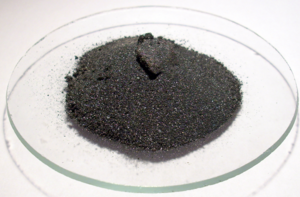Difference between revisions of "Iron filings (ZVI)"
Jenny Hill (talk | contribs) m (→Benefits) |
Jenny Hill (talk | contribs) m |
||
| (One intermediate revision by the same user not shown) | |||
| Line 1: | Line 1: | ||
[[File:Železo.png|thumb|ZVI]] | |||
==What is it?== | ==What is it?== | ||
ZVI is scrap iron filings and describes the elemental form of iron with a zero charge carried by each atom – a result of the outer valence level being filled. ZVI is able to remove phosphate from solution through precipitation. <ref name=Rossetti>Rossetti M. Evaluation of phosphorous removals by biochar supported nano-scale zero-valent iron. 2017. Chemical Engineering Undergraduate Honors Thesis.</ref> Zero-valent iron nanoparticles (nZVI) are also used for [[phosphorus]] removal. | ZVI is scrap iron filings and describes the elemental form of iron with a zero charge carried by each atom – a result of the outer valence level being filled. ZVI is able to remove phosphate from solution through precipitation. <ref name=Rossetti>Rossetti M. Evaluation of phosphorous removals by biochar supported nano-scale zero-valent iron. 2017. Chemical Engineering Undergraduate Honors Thesis.</ref> Zero-valent iron nanoparticles (nZVI) are also used for [[phosphorus]] removal. | ||
| Line 8: | Line 9: | ||
Another paper reports that ZVI can remove up to 98% of influent phosphorus at low input concentrations, and at high concentrations is shown to remove up to 36% of incoming phosphorus. The phosphorus retained in the soil is mostly iron-bound, which will not be easily leached out of the system because it is very stable.<ref>Lechner L. Phosphorus Removal From Stormwater Using Zero-Valent Iron. 2016. Applied Science Masters Thesis.</ref> | Another paper reports that ZVI can remove up to 98% of influent phosphorus at low input concentrations, and at high concentrations is shown to remove up to 36% of incoming phosphorus. The phosphorus retained in the soil is mostly iron-bound, which will not be easily leached out of the system because it is very stable.<ref>Lechner L. Phosphorus Removal From Stormwater Using Zero-Valent Iron. 2016. Applied Science Masters Thesis.</ref> | ||
---- | |||
[[category:materials]] | [[category:materials]] | ||
[[category:phosphorus]] | [[category:phosphorus]] | ||
[[Category: Water quality]] | [[Category: Water quality]] | ||
Latest revision as of 03:10, 9 March 2018
What is it?[edit]
ZVI is scrap iron filings and describes the elemental form of iron with a zero charge carried by each atom – a result of the outer valence level being filled. ZVI is able to remove phosphate from solution through precipitation. [1] Zero-valent iron nanoparticles (nZVI) are also used for phosphorus removal.
How is it being used?[edit]
No projects that use ZVI were found in Ontario.
Benefits[edit]
A study was done that compared the phosphorus reduction capabilities of ZVI, biochar, biochar-supported ZVI (ZVI/BC), and biochar-supported nZVI (nZVI/BC). [1] It was found that nZVI/BC had the highest phosphorus reduction. Using biochar-supported ZVI or nZVI improves the dispersion and stability of the iron filings. Biochar is fine-grained and highly porous, providing a large surface area to support nZVI. Another paper reports that ZVI can remove up to 98% of influent phosphorus at low input concentrations, and at high concentrations is shown to remove up to 36% of incoming phosphorus. The phosphorus retained in the soil is mostly iron-bound, which will not be easily leached out of the system because it is very stable.[2]
